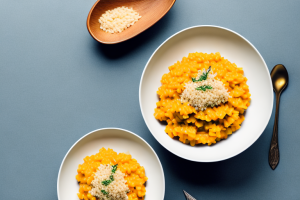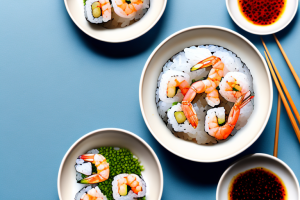How to prepare sushi rice with California rolls
8 min read
A bowl of sushi rice with california rolls arranged around it
When it comes to Japanese cuisine, few dishes are more beloved than sushi. And within the world of sushi, one of the most popular variations is the delicious California roll. This sushi roll features a filling of crab, avocado, and cucumber, delicately wrapped in sushi rice and seaweed. Making California rolls from scratch may seem daunting, but with the right ingredients and techniques, anyone can create this tasty dish at home. In this article, we’ll guide you through the entire process, starting with the most crucial component: sushi rice.
The history of California rolls and sushi rice
In the 1970s, a chef named Ichiro Mashita created the now-famous California roll. Mashita, who was based in Los Angeles, noticed that his American customers were hesitant to try traditional sushi, which often featured raw fish. To appeal to their tastes, he developed a sushi roll that instead featured cooked crab meat, cucumber, and avocado. This new twist on sushi quickly became popular in California and eventually spread throughout North America and the rest of the world.
At the heart of every sushi roll, including California rolls, is the sushi rice. This type of rice is short-grain and sticky, making it ideal for rolling and shaping into sushi. Sushi rice is also seasoned with a mixture of vinegar, sugar, and salt, which gives it a lightly sweet and tangy flavor that pairs perfectly with the other ingredients in California rolls.
While California rolls are now a staple in many sushi restaurants, they are not actually a traditional Japanese dish. In fact, many Japanese sushi chefs were initially skeptical of the California roll, as it deviated so far from the traditional ingredients and preparation methods of sushi. However, as the popularity of the California roll grew, many Japanese chefs began to incorporate similar Western-inspired twists into their own sushi creations.
Today, sushi rice is not only used for making sushi rolls, but also for a variety of other dishes. Sushi rice bowls, or donburi, are a popular Japanese dish that features sushi rice topped with various meats, vegetables, and sauces. Sushi rice is also used in sushi salads, sushi burritos, and even sushi burgers. The versatility of sushi rice has made it a beloved ingredient in both traditional and modern cuisine.
What are the ingredients required for making sushi rice and California rolls?
To make sushi rice for California rolls, you’ll need the following ingredients:
- Sushi rice
- Rice vinegar
- Sugar
- Salt
- Water
For the California roll filling, you’ll need:
- Cooked crabmeat
- Sliced avocado
- Sliced cucumber
- Nori seaweed sheets
Optional additions could include mayonnaise and sesame seeds for added flavor and texture.
It’s important to note that the quality of the ingredients used can greatly affect the taste and overall experience of making sushi rice and California rolls. When selecting sushi rice, look for short-grain rice that is specifically labeled as sushi rice. For the crabmeat, fresh is always best, but if using canned, be sure to drain it well before use. When slicing the avocado and cucumber, make sure to cut them into thin, even slices for optimal texture and presentation. Lastly, when selecting nori seaweed sheets, look for ones that are dark green and have a slightly shiny appearance, as this indicates freshness.
Tips for selecting the best quality rice for sushi
When choosing the rice for your sushi, it’s important to select a high-quality short-grain variety. Look for rice labeled “sushi rice” or “Japanese rice” at your local grocery store. You can also find sushi rice online or at Asian food markets. Avoid using long-grain or medium-grain rice, as they won’t result in the ideal texture for sushi.
Another important factor to consider when selecting sushi rice is the level of stickiness. The ideal sushi rice should be sticky enough to hold together when rolled, but not so sticky that it becomes clumpy or difficult to work with. To achieve the perfect level of stickiness, rinse the rice thoroughly before cooking and use the correct ratio of water to rice. Additionally, consider using a rice cooker to ensure consistent results every time.
How to rinse and soak the rice before cooking
Before cooking your sushi rice, you’ll need to rinse it thoroughly to remove any excess starch. Here’s how:
- Place the sushi rice in a fine-mesh strainer and rinse it under cold water until the water runs clear. This should take about 2-3 minutes.
- Transfer the rinsed rice to a bowl and cover it with water. Let it soak for at least 30 minutes, or up to 1 hour.
Soaking the rice not only helps to remove excess starch, but it also helps to improve the texture and flavor of the rice. During the soaking process, the rice grains absorb water, which makes them plump and tender when cooked.
It’s important to use the right amount of water when soaking the rice. Too much water can make the rice mushy, while too little water can result in unevenly cooked rice. As a general rule, use 1 1/2 cups of water for every cup of sushi rice.
A step-by-step guide to cooking perfect sushi rice
Follow these steps to cook perfectly fluffy sushi rice:
- Drain the soaked rice in a fine-mesh strainer and transfer it to a medium-sized pot with a tight-fitting lid.
- Add 1 1/4 cups of water to the pot.
- Bring the water and rice to a boil over high heat. Once boiling, reduce the heat to low and cover the pot with the lid.
- Simmer the rice for 15-20 minutes, or until all the water has been absorbed.
- Remove the pot from the heat and let it sit, covered, for an additional 10 minutes. This allows the rice to absorb any remaining moisture and become tender and fluffy.
It’s important to note that the quality of the rice you use can greatly affect the outcome of your sushi rice. Look for short-grain Japanese rice, which is specifically cultivated for sushi making. Additionally, rinsing the rice before soaking can help remove excess starch and improve the texture of the final product. Finally, consider adding a mixture of rice vinegar, sugar, and salt to the cooked rice for added flavor and to help it stick together when making sushi rolls.
The ideal water-to-rice ratio for making sushi rice
The ideal water-to-rice ratio for sushi rice is 1.25 to 1, meaning you’ll need 1¼ cups of water for every cup of sushi rice.
It’s important to note that the quality of the water used can also affect the taste and texture of the sushi rice. It’s recommended to use filtered or bottled water to ensure the best results. Additionally, rinsing the rice before cooking can help remove excess starch and improve the overall texture of the rice.
How to season the cooked rice with vinegar, sugar, and salt
In a small saucepan, combine 1/4 cup of rice vinegar, 2 tablespoons of sugar, and 1 teaspoon of salt. Heat the mixture over low heat, stirring until the sugar has dissolved. Once the sushi rice is fully cooked, transfer it to a large bowl and pour the vinegar mixture over it. Use a wooden spoon or spatula to gently fold the vinegar mixture into the rice, being careful not to crush it or overmix.
It is important to note that the amount of vinegar mixture used to season the rice can vary depending on personal preference. Some people prefer a stronger vinegar taste, while others prefer a milder flavor. It is recommended to start with a smaller amount of the mixture and gradually add more until the desired taste is achieved.
Additionally, leftover seasoned rice can be stored in the refrigerator for up to 2 days. To prevent the rice from drying out, cover it with a damp paper towel or plastic wrap before storing. When reheating the rice, add a small amount of water or additional vinegar mixture to help restore its moisture and flavor.
Techniques for rolling California rolls with sushi rice
Once your sushi rice is seasoned, it’s time to roll the California rolls. Here’s how:
- Lay a sheet of nori, shiny side down, on a rolling mat or a clean kitchen towel.
- With moistened fingers, evenly spread a layer of sushi rice over the nori, leaving a 1-inch border at the top of the sheet.
- Arrange the crabmeat, avocado, and cucumber in a line across the center of the rice.
- Using the mat or towel to help you, tightly roll the nori and rice around the filling, pressing gently as you go.
- Moisten the top border of the nori with a bit of water and finish rolling the sushi.
- Wrap the rolled sushi tightly in plastic wrap and refrigerate it for at least 30 minutes. This allows the rice to set and makes it easier to slice the sushi without it falling apart.
One important tip to keep in mind when rolling California rolls is to not overfill them. Overfilling can cause the roll to burst or fall apart when slicing. It’s better to start with a smaller amount of filling and add more as needed. Additionally, using a sharp knife to slice the sushi will help create clean, even slices.
The art of cutting sushi rolls without squishing them
To slice your California rolls, use a sharp, wet knife. Dip the blade of the knife in hot water and gently wipe it dry with a clean towel before making each cut. Slice the rolls into 6-8 evenly sized pieces. Press down firmly with the knife but be careful not to squish the sushi. Serve the California rolls with soy sauce, wasabi, and pickled ginger on the side.
Variations of California rolls that you can prepare with sushi rice
The great thing about sushi is that there are countless variations you can try. To mix things up, try adding other fillings to your California rolls like spicy tuna, tempura shrimp, or smoked salmon. You could also experiment with different types of seaweed, such as soy paper or cucumber slices, in place of nori.
How to serve and enjoy your homemade California rolls with sushi rice
Serve your homemade California rolls on a platter or individual plates, garnished with pickled ginger and wasabi. Squeeze a small amount of soy sauce onto your plate and use it to dip your sushi into before taking a bite. Enjoy your fresh, homemade California rolls with family and friends!
Common mistakes to avoid when cooking sushi rice and making California rolls
One of the most common mistakes when making sushi rice is using too much water. This can result in mushy, overcooked rice. Additionally, avoid packing the rice into the roll too tightly, as this can cause it to fall apart. Also, be sure to use a sharp knife when slicing the sushi to avoid squishing it.
Expert tips and tricks for perfecting your sushi rice and California roll-making skills
Here are a few expert tips and tricks to take your sushi rice and California roll-making skills to the next level:
- Use a rice cooker to simplify the cooking process and ensure perfectly cooked rice every time.
- When rolling the sushi, use firm pressure but not too much. You want the rice to stick to the nori, but not so much that the roll becomes dense.
- Try using different types of sushi vinegar, such as black vinegar or yuzu vinegar, for a unique twist on the classic flavor.
With these tips and tricks in mind, you’ll be a sushi-making pro in no time!


